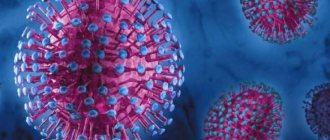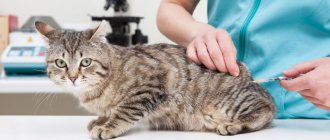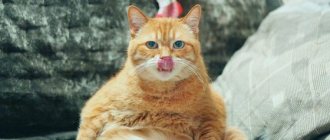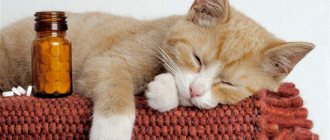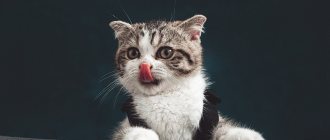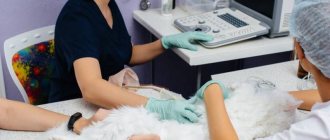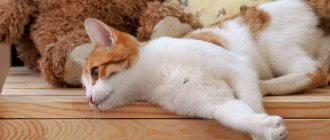Doctors often encounter misunderstandings among owners when they try to explain that the cat does not have constipation, but megacolon. What is the difference between these concepts?
Constipation (also referred to as constipation or constipation) is difficult or systematically insufficient defecation, that is, bowel movement.
Megacolon is a form of long-term constipation when the colon becomes full of hard and dried stool.
Constipation can most often be treated with medication, but sometimes it is necessary to resort to surgery.
Description
Megacolon is a chronic increase in the diameter of the large intestine, most often the colon.
This is where electrolytes and moisture are absorbed from the stool. Usually the excrement moves further, accumulating before the act of defecation in the rectum. With megacolon in cats, the movement of masses ends in the thick section. Excretion occurs due to peristalsis - wave-like contractions. Due to complete or partial loss of motility, a section of the intestine loses tone, increasing in diameter. A “pocket” is formed where feces accumulate, further drying and pressing.
Soon the density and volume of the masses reach values that make the natural process of emptying impossible. Fecal stones irritate the intestinal walls, which, against the background of chronic intoxication, leads to a deterioration in the general condition of the cat. Megacolon without treatment leads to irreversible changes in the nerves and smooth muscles of the colon, peritonitis, sepsis, failure of internal organs, and perforation of the intestinal walls.
This is not a separate disease, but a clinical sign of a disease or pathology. Maine Coons, Himalayans and Persians are prone to megacolon due to the structure of their pelvis. In the absence of specific causes, megacolon in cats is most often diagnosed between the ages of 4 and 7 years, secondary - regardless of age.
Anatoly Chernikov
Chief veterinarian of the network of veterinary clinics “101 Dalmatians”, graduate of the Moscow State Academy of Veterinary Medicine named after.
K.I. Scriabin (2009). Specialist in the field of dentistry, gastroenterology, endoscopy. Regularly takes part in domestic and international Veterinary Conferences: Moscow International Veterinary Congress, National Veterinary Conference (NVC), Congress of the European Association of Veterinary and Comparative Dietetics (ESVCN), Southern European Veterinary Conference (SEVC), Conference of the International Community Felinological Medicine (ISFM), Conference of the Russian Gastroenterological Academy (RGA), International Veterinary Conference Purina Partners. Colitis (Latin colitis; from Greek kolon - large intestine, and Greek itis - inflammatory process) is inflammation of the large intestine, usually accompanied by a deterioration in the absorption of water and electrolytes, which leads to diarrhea. In addition to diarrhea, colitis in cats can be accompanied by tenesmus, dyschezia, hematochezia, borborygmus, and the appearance of mucus in the feces. Pain and impaired peristalsis can also lead to difficulty in normal bowel movements and impaired peristalsis.
Causes
In 70% of cases we are talking about the idiopathic form. This is a primary condition for which there is no cause or one cannot be determined. About half of these cases occur due to pathology of the innervation of the colon, in which the nerves necessary to communicate with the brain do not function or are absent. Treatment is only surgical.
The remaining 30% are diagnosed with a wide range of causes:
- congenital dysfunction, structural pathology;
- diseases of the gastrointestinal tract, endocrine system, central nervous system, amyloidosis, collagenosis;
- long-term use of medications, chronic intoxication;
- intestinal infections, parasites, neurological damage;
- hypokalemia, hypercalcemia, other metabolic disorders;
- neoplasms, foreign body, pelvic fracture, narrowing of the anus.
Predisposing factors are low physical activity, chronic constipation, obesity, anorexia, poor diet, and oral diseases. Usually, several causes of megacolon in cats are identified, which together lead to impaired evacuation. For unknown reasons, cats are more likely to get sick.
In kittens, the pathology occurs against the background of congenital structural anomalies. When possible, surgical correction is indicated. Another common cause of megacolon in kittens is congenital disorders of the central nervous system, usually fatal. Aganglionic megacolon appears due to underdevelopment of certain areas of the colon. This leads to death several months after birth, although there is a chance to eliminate the pathology surgically.
Basic information about the disease
Some veterinarians and owners call this a severe form of constipation, but this is not entirely true. If we talk about the scientific definition of this pathology, then actually this is the name of the disease associated with distension and overflow of the colon. Actually, in Latin the latter is called intestinum colon, and the word Mega, accordingly, means something very large. Now let’s talk about what is meant by the word “constipation”.
This designates a pathology in which the “journey” of food through the digestive tract is significantly prolonged. As a result, the stool becomes dry and hard. The term "persistent constipation" refers to a long-term variant of the disease. Thus, megacolon is a form of long-term constipation when the colon becomes overcrowded with hard and dried feces. Why does such an unpleasant phenomenon develop?
There are many causes of pathology! But at least 2/3 of cases are called “idiopathic megacolon”, since it is not possible to reliably determine the cause of the disease. However, veterinarians suggest that this problem is somehow related to defects in the smooth muscles of the colon. Other causes include: narrowing of the pelvic area (often due to severe fractures), nerve or spinal cord damage, which is especially common in Manx tailless cats. Oddly enough, but ordinary inflammation is one of the rarest causes (along with tumor diseases of the colon).
Symptoms
In adult cats, megacolon develops over months, sometimes years, resulting in chronic problems with defecation. At first they can be resolved by changing the diet, laxatives, and oil. But it is obvious that from time to time the pet is still bothered by this process - the toilet once or twice a week, dry stools, meowing in pain, several trips to the litter box in a row.
If a cat associates unpleasant sensations with the litter box, it begins to defecate in a secluded place. With a strong emotional connection with the owner, he does this demonstratively, in unexpected places - on the table, pillow, in his arms.
Symptoms of feline megacolon increase as intestinal motility worsens:
| Symptoms | Description |
| Flatulence, constipation | In scanty masses there is mucus and blood. The smell is putrid. |
| Diarrhea | Liquid, foul-smelling, does not lead to the evacuation of stones. Usually lasts up to 2 days, followed by constipation. |
| Vomit | Abundant, uncontrollable with a characteristic stench due to dysbacteriosis, intestinal blockage. |
| Poor appetite, refusal of water | Due to a feeling of fullness in the abdomen, a cat suffering from megacolon refuses to drink or eat. The pet loses weight, even if its appetite is preserved. |
| Painful stomach | Tight, “frog-like” rounded. In advanced cases, accumulated masses can be felt. |
| Wool | Dry, dull, brittle. The long fur coat falls off. Sluggish, constant shedding leading to bald spots. |
| Apathy | Depressed state - the cat lies down all the time, refuses to play, does not go to be held, stops caring for itself, hides in secluded places. |
| Chronic dehydration | Check by gathering a fold of skin with your fingers - hold for 10 seconds, release. Dehydrated tissues straighten slowly, healthy ones instantly. |
In advanced cases, the diameter of the colon is comparable to the forearm of an adult. The increased volume of the intestine puts pressure on the internal organs and the diaphragm. This leads to cyanosis (blue lips, palate, gums), tachycardia, shortness of breath. The pet gets tired quickly, after activity it breathes with an open mouth, lying on its side. An obsessive cough appears, creating favorable conditions for pneumonia.
Types of colitis in cats
Listed below are the main common diseases accompanied by colitis. Many of these pathologies often have a mixed pathogenesis, causing colitis, enteritis and even gastritis, but within the framework of the topic they will be considered mainly in the context of inflammation of the large intestine.
Acute idiopathic colitis
Acute inflammation of the large intestine, accompanied by diarrhea, is quite common in cats. As a rule, this pathological condition does not require specific treatment and has a nutritional etiology: errors in feeding, exposure to irritating and toxic substances, short-term exposure to pathogenic microflora and its toxins.
Often the inflammation is not limited to the large intestine. Mixed inflammation of the large and small intestines is common in an acute process. In rare cases, prolonged illness requires specific symptomatic treatment.
The most favorable feeding option for acute colitis is considered to be frequent feeding in small portions of easily digestible food with a limited number of protein sources. Among the commercial diets that meet these requirements are PRO PLAN® VETERINARY DIETS EN ST/OX GASTROINTESTINAL. For colonic diarrhea, fiber supplements are often recommended because they help normalize colonic motility, bind intestinal irritants, and nourish and protect the intestinal mucosa (eg, by fermenting soluble fiber into SCFAs).
In cases of unknown cause of acute colitis, antibiotics should not be routinely used as they have an adverse effect on the healthy gut microbiome and promote the emergence of resistant strains of bacteria. The rapid course, the inability to identify the exact cause of the disease and the lack of need for etiotropic therapy allows us to call “acute colitis” of cats an idiopathic disease and distinguish it as a separate nosological unit. Although the greatest difficulty is in the treatment of chronic colitis, it must be noted that many of the diseases listed below can occur chronically and acutely (including).
Helminthiasis
Trichuris spp. (Trichocephalosis)
The helminths that cause colitis in cats include the whipworms Trichuris campanula and Trichuris serrata. Worms of the genus Trichuris are parasites of the mucous membrane of the large intestine. The infection is transmitted by the fecal-oral route. The eggs are swallowed and develop into larvae. The larvae subsequently migrate to the cecum and colon, where they develop into adults. Adults use a mouth spear to pierce and tear the tissue, blood vessels and epithelial cells on which they feed. (12)
Parasites can cause severe typhlitis and colitis. Characteristic clinical signs of colitis caused by helminths are prolonged colonic diarrhea with mucus, tenesmus and hematochezia. Severe infestations may be accompanied by eosinophilia, anemia and hypoproteinemia.
Diagnostics.
Diagnosis is made based on the detection of parasite eggs in the stool or detection of parasites during a colonoscopy.
Therapy.
Drugs effective in treating Trichuris spp. infections include fenbendazole and febantel. Immature worms are less susceptible to drug treatment, and it takes approximately 3 months for the larvae to mature into oviparous adults. Therefore, treatment should be repeated after 3 weeks and again after 3 months. Feces should be promptly removed from the tray and regular wet cleaning of the premises should be carried out.
Protozoonoses
Tritrichomonas foetus (Trichomoniasis, trichomoniasis)
is a flagellated protozoan with three anterior flagella and a wavy membrane. It was first identified as a cause of chronic colonic diarrhea in cats in 2003. (3)
Trichomoniasis is most common among overcrowded cats (31% of 117 cats from 89 catteries selected at an international cat show). (4) Infected cats typically range in age from 3 months to 13 years (average age 9 months).
T. foetus colonizes the distal ileum and colon, where trophozoites can be found in close proximity to the mucosal surface or in the lumen of colonic crypts. (5) Less commonly, subepithelial invasion of Trichomonas may also be observed.
The infection is accompanied by chronic or recurrent colonic diarrhea, characterized by mucus secretion, tenesmus, and periodic hematochezia. The anal area is often inflamed, and cats often exhibit fecal incontinence. However, most cats are usually in good health, showing normal mental status and normal appetite.
Diagnostics.
Trichomoniasis can be diagnosed by identifying trophozoites in feces through examination of a native smear, using PCR diagnostics; less commonly, the method of culturing protozoa or examining biopsies of the mucous membrane of the large intestine are used.
Therapy.
Studies have shown that ronidazole is effective in killing feline isolates of T. foetus in vitro and killing T. foetus in experimentally infected cats. (6) The recommended dose is 30 mg/kg q24h PO for 14 days. Given the possible neurological side effects, treatment with ronidazole should only be considered in cases of confirmed T. foetus and with informed consent from the owner.
Entamoeba histolytica (Amebiasis)
is the causative agent of human amoebic dysentery. The infection is rare in cats and is acquired by consuming food or water contaminated with human feces containing infectious cysts. Trophozoites live in the lumen of the colon and penetrate the submucosa, secreting lytic factors that allow them to destroy and ulcerate the mucosa. These pathogenic effects lead to the appearance of necrotizing ulcerative colitis in cats and, as a consequence, colonic diarrhea with mucus and blood.
Diagnostics.
Diagnosis is made by detection of amoeboid trophozoites in native smears of diarrheal feces or by detection of quadruple cysts in feces after flotation.
Therapy.
Metronidazole is used in treatment.
Mycoses
Histoplasma capsulatum (Histoplasmosis).
Histoplasma is a dimorphic fungus that causes histoplasmosis in cats. Infection occurs by inhaling the spores. Some fungal infections cause changes in the lungs, but can also cause lesions in other areas of the body, including the gastrointestinal tract.
Symptoms in affected animals can range from mild chronic colonic diarrhea to severe intestinal damage with tenesmus, hematochezia, mucus-laden feces, fever, and decreased body weight.
Diagnostics
consists of conducting a cytological examination of a colorectal sample or identifying the pathogen in a biopsy of the mucous membrane.
Therapy.
Treatment is usually monotherapy with itraconazole (10 mg/kg po once every 12-24 hours) (7), or its combination with amphotericin B (0.25-0.5 mg/kg IV every 48 hours until total cumulative dose 4-8 mg/kg for cats) The prognosis for long-term (4-6 months) antifungal treatment is usually favorable, but depends on the extent of the lesion.
or its combination with amphotericin B (0.25-0.5 mg/kg IV every 48 hours until total cumulative dose 4-8 mg/kg for cats) The prognosis for long-term (4-6 months) antifungal treatment is usually favorable, but depends on the extent of the lesion.
Other mycoses that affect the intestines are relatively rare.
Pythium spp. (causing pythiosis)
is able to penetrate into the tissues of the digestive tract, causing severe granulomatous gastroenteritis. Symptoms of the disease include chronic, poorly controlled diarrhea, vomiting, anorexia, depression, lethargy and weight loss.
Diagnostics.
During physical examination, the animal often reveals neoplasms in the abdominal cavity or severe local thickening of the intestine. The diagnosis is made based on the identification of the pathogen in a biopsy of the intestinal mucosa after histological examination.
Therapy.
Treatment consists of radical surgical excision of the granulomatous formation within healthy tissue (from 3 to 4 cm outside the pathological focus). (9) Due to frequent postoperative relapses, postoperative drug therapy with itraconazole (10 mg/kg po every 24 hours) and terbinafine (5–10 mg/kg po every 24 hours) is recommended. (9) The medications should be continued for 2–3 months.
Bacterial colitis
The causes of bacterial colitis in cats are poorly understood. Determining which specific bacteria caused colitis can be very difficult, since many bacteria can be part of the normal intestinal microflora and are only opportunistic pathogens. In addition, diagnosable presumptive bacterial pathogens are frequently identified in both cats with diarrhea and clinically healthy cats. This clinical picture makes diagnosis very difficult. Thus, cases of isolation of E. coli and Salmonella spp., C. perfringens from the feces of clinically normal cats have been described. (10) Young animals are known to be more susceptible to developing bacterial diarrhea.
Causes of bacterial colitis in cats
Clostridium perfringens (Clostridiosis).
It is a gram-positive, anaerobic, spore-forming bacillus. The pathogenesis of C. perfringens-associated diarrhea in cats is still unclear. However, the disease most likely occurs secondary to an imbalance of the animal's commensal microflora due to indiscriminate antimicrobial therapy, a sudden change in diet, or intestinal disease, resulting in mass sporulation of resistant vegetative organisms with subsequent release of enterotoxin or other virulence factors.
Patients experience colonic diarrhea, often with blood and mucus. Weight loss, vomiting and anorexia are extremely rare.
Therapy.
C. perfringens is usually sensitive to tylosin or amoxicillin, and most affected animals resolve clinical signs within 1 to 3 days of starting one of these drugs. If the patient responds to such therapy, antibiotic therapy should be continued for an additional 10 to 14 days.
Clostridium difficile (Clostridiosis).
It is a gram-positive, anaerobic, spore-forming bacillus. The disease is likely spread by the fecal-oral route.
C. difficile is the leading cause of antibiotic-associated diarrhea in humans. When conditions are optimal (usually due to destruction of commensal colonic flora by antibiotic use), toxigenic C. difficile multiplies and produces toxin A (enterotoxin) and/or toxin B (cytotoxin), which cause cell destruction, necrosis, and diarrhea. In a study conducted at a veterinary school in the United States, 23 of 189 inpatient cats were found to shed C. difficile in their feces, and 8 of these 23 cats carried toxigenic strains. (eleven)
Therapy.
If C. difficile is suspected as the cause of diarrhea, metronidazole is the drug of choice.
Salmonella spp. (Salmonellosis).
These are gram-negative rods that are sometimes isolated in the feces of both healthy and sick cats with signs of diarrhea. Clinical salmonellosis is quite rare, indicating a predominant carriage of the infection. Transmission usually occurs orally (either ingestion or fecal-oral route), although ocular and transplacental routes have also been reported. Feeding raw meat are other potential sources of infection. (12) Infected cats may shed Salmonella spp. in their feces for at least 14 weeks and, although cat-to-human transmission is a concern, it has been reported very rarely. (13)
Enterotoxicosis caused by Salmonella is characterized by acute watery diarrhea or loose stools with mucus, vomiting, fever, development of dehydration, anorexia and tenesmus. Most animals recover within 3–4 weeks; in rare cases, salmonellosis progresses to a fatal form with bacteremia.
Diagnostics.
To make a diagnosis, a detailed medical history, clinical signs of the disease, cultivation of pathogenic microorganisms, and exclusion of other causes of enterocolitis are necessary.
Therapy.
Antibiotic treatment is a controversial issue. Antibacterial therapy for colitis in cats can change the balance of the microbiota, which prolongs the shedding of Salmonella in feces and promotes the formation of carriage. The use of antibiotics is indicated when salmonellosis progresses until clinical (fever, weakness, hematochezia) or laboratory (neutropenia, hypoglycemia) signs of bacteremia and endotoxemia appear. Antibiotics reported to be effective in treating Salmonella include chloramphenicol, amoxicillin, trimethoprim-sulfamide, and enrofloxacin.
Campylobacter spp. (Campylobacteriosis).
It is a gram-negative microaerophilic bacterium that is a dangerous pathogen for both humans and animals. It is transmitted by the fecal-oral route, including through contaminated food and water.
Campylobacter spp. cause disease by invading the epithelium of the distal small intestine and the epithelium of the colon, where they produce cytotoxins and/or enterotoxins. Clinical signs include profuse watery diarrhea with mucus (with or without blood and white blood cells), partial anorexia, occasional vomiting, and mild fever lasting 3 to 7 days.
Therapy.
The first choice drugs are erythromycin (at a dose of 10–15 mg/kg orally every 8 hours for 7 days) or enrofloxacin (at a dose of 5 mg/kg orally once a day). Treatment with antibiotics does not guarantee complete destruction of bacteria, and re-infection is possible in nursery conditions.
Viral colitis
Feline coronavirus enteritis (FECV) is a worldwide viral infection that affects the mature apical epithelium of the small intestinal villi. Although the infection primarily affects the small intestine, disease of the large intestine may be the primary manifestation of feline infectious peritonitis (FIP). (14, 15) Also, in the chronic course of the disease, especially with uncontrolled antibiotic therapy, pronounced clinical signs of colonic diarrhea may be observed, probably associated with a disturbance in the normal balance of the intestinal microbiota. Treatment of such animals requires a comprehensive, balanced approach.
Inflammatory diseases of the large intestine
IBD is an idiopathic inflammatory disease affecting the gastrointestinal (GI) tract of cats. Diagnosis is made based on clinical and histopathological criteria.
Clinically, IBD is diagnosed in animals with chronic (lasting more than 3 weeks) signs of inflammation of the gastrointestinal tract, such as anorexia, vomiting, diarrhea (small or large intestinal), weight loss, for which no other etiological causes can be identified. The local process (with inflammation of the large intestine) is usually limited to colonic diarrhea with tenesmus, hematochezia and mucus without signs of general malaise. Sick animals usually do not respond to symptomatic treatment.
Histopathological analysis of the colon mucosa usually reveals inflammatory infiltration predominantly of round cells (lymphoplasmacytic colitis), eosinophils (eosinophilic colitis), neutrophils (neutrophilic colitis), macrophages (granulomatous colitis), or a combination of these. (16) IBD is clearly a multifactorial disease in which the physiological interactions of the innate and adaptive immune systems with luminal microbial antigens are disrupted. (18) Three factors are believed to be necessary for the development of IBD: (17)
- the presence of pathological bacteria in the intestinal lumen with potential dysbiosis in the lumen microbiome;
- impairment of the mucosal barrier function that allows bacterial and/or food antigens to come into contact with innate and adaptive immune cells;
- impaired innate and adaptive immune responses of the mucous membrane to bacterial and food antigens.
Therapy.
To begin treatment for IBD, it is first necessary to exclude other possible causes of inflammation of the large intestine. The necessary diagnostic tests should be performed and empirical treatment prescribed if necessary. Considering the expected complex etiopathogenesis of IBD, therapy should also be comprehensive.
Diet therapy
may be as follows (Scheme 1):
- using food with a new source of protein or with hydrolyzed protein (hypoallergenic diet);
- use of easily digestible dietary components; (18)
- prescribing a diet high in dietary fiber (19).
Any of the approaches to dietary therapy for colonic IBD, as well as their combination, may be effective. It is also important to understand that it is necessary to use one or another option of diet therapy for at least 4 weeks to assess the therapeutic effect. When choosing an allergen-free diet, it is best to choose a product with hydrolyzed protein. Thus, the likelihood of an allergenic diet is reduced to the lowest values. A good option would be PRO PLAN® VETERINARY DIETS HA ST/OX HYPOALLERGENIC - food with hydrolyzed protein and low allergenicity, with excellent taste.
The use of probiotic supplements with a proven clinical effect for animals with gastrointestinal diseases, such as Enterococcus faecium SF 68 (PRO PLAN® VETERINARY DIETS FORTIFLORA), can also have a positive effect in the treatment of colonic IBD as part of complex therapy.
Specific pharmacological therapy
colonic IBD (Table 2) is required if nutritional therapy does not control clinical signs or can be initiated simultaneously with dietary changes in severe cases. Among the antimicrobials, metronidazole is often used in the initial treatment of cats with colitis. In addition to its antimicrobial action against various pathogenic anaerobic bacteria, metronidazole is also effective against Giardia spp. In addition, metronidazole has an immunomodulatory effect. (20)
Sulfasalazine is a sulfamide derivative of mesalazine. The anti-inflammatory effect of the sulfasalazine metabolite, 5-aminosalicylic acid (5-ASA) on the colon mucosa is associated with inhibition of cyclooxygenase and a decrease in the synthesis of prostaglandins and leukotrienes. (21) The main side effect of sulfasalazine is keratoconjunctivitis sicca (KS), and cats may also develop anorexia, vomiting, and anemia.
Glucocorticoids (prednisolone) are used as second-line treatment for colonic IBD that is refractory to diet therapy and treatment with metronidazole and sulfasalazine. Given the risks of adverse reactions with sulfasalazine, the use of prednisolone in cats in the early stages of IBD treatment is preferable to that in dogs.
In cases of refractoriness to immunosuppressive doses of glucocorticoids, additional immunosuppressive drugs such as chlorambucil and cyclosporine may be useful. Because of potential side effects and financial considerations, these drugs should be prescribed to patients under the strict supervision of a physician.
Diagnostics
At the first contact, you need to tell details about the pet’s condition - anamnesis plays an important role in the diagnosis of megacolon. When a problem was noticed, were there any attempts at treatment, diet, concomitant diseases, frequency and volume of stool. It is advisable to bring excrement with you in a sterile container for testing.
An experienced doctor will detect a delay in evacuation already during the examination. An x-ray with contrast is immediately taken to identify obstruction and foreign objects. The image clearly shows swollen loops, fecal stones, and sometimes the problem area is identified. This is usually enough to confirm the diagnosis.
To assess the general condition and identify the cause, a full examination is carried out:
- X-ray of the chest, pelvis;
- Ultrasound of the abdominal organs;
- T4 level to exclude hypothyroidism;
- consultation with a cardiologist, neurologist;
- exclude parasitic and infectious diseases;
- General and biochemical tests of blood, urine, feces.
In controversial cases, a colonoscopy is necessary. But this method is not available in most clinics and is performed under general anesthesia. More often, doctors rely on their own eyes - since they have to do anesthesia anyway, they immediately perform the operation, simultaneously assessing the condition of the intestines. But this is only permissible if the surgeon is experienced.
Treatment
The primary tasks are to relieve intoxication, eliminate dehydration, and evacuate feces using laxatives or an enema. Unfortunately, conservative treatment of megacolon in cats is rarely effective. Usually a subtotal colectomy is indicated - an operation to remove the problem area. Even if the cause is identified and eliminated, the distended intestines cannot be returned to normal.
First aid
You cannot help your pet on your own. Laxatives, emollients, and motility modulators can cause irreparable harm. Especially if we are talking about blockage of the lumen, neoplasm, internal bleeding, or a large accumulation of stones. Only a veterinarian can rule this out.
If it is impossible to show the cat to a doctor immediately, vegetable puree and non-acidic kefir are introduced into the diet. As a last resort, give a teaspoon of Vaseline oil or Duphalac at the rate of 0.5 ml per 1 kg of weight with a syringe without a needle. If you react with diarrhea, the next dose is given after 10 hours, reducing it by a third. The use of laxatives during obstruction can cause intestinal rupture!
Basic treatment
Resection of all or most of the colon is the removal of a “pocket” in which excrement accumulates. The healthy ends of the intestine are stitched together, restoring its function along its entire length. Stretched loops cannot be returned to normal with medications, although most owners insist on this attempt.
Doctors agree if there are no serious disturbances in the functioning of the body. Otherwise, it will be more difficult for the pet to endure anesthesia, which, even without taking into account other risks, makes postponing the operation unreasonable.
Therapy helps in mild cases, in the early stages and as a means of eliminating symptoms when surgery is unacceptable:
- Mucofalk, Metamucil, Senade - plant extract stimulates the intestines with coarse fibers;
- Duphalac, Normaze (lactulose) - increases osmotic pressure, softens stools, increases volume, stimulates peristalsis;
- Enterosgel, Filtrumsti reduce intoxication;
- Vaseline oil, petrolatum - without being absorbed, they facilitate the passage of masses through the intestines, preventing microtraumas;
- Cisapiride is a strong laxative that stimulates gastrointestinal tone and motility;
- SSD antibiotics suppress pathogenic flora.
The drugs are prescribed in the form of suspensions, suppositories, and enemas. If treatment does not help, the intestinal contents are evacuated mechanically under general anesthesia. Some owners prefer to take their cats for this procedure several times a year rather than decide to have the surgery done once. Practice indicates a temporary effect - they still come to the need for surgical intervention, but for acute indications.
Veterinary clinic of Dr. Shubin
Description
Megacolon is a chronic and pathological increase in the diameter of the colon, usually filled with dried feces.
Megacolon is a Latin term consisting of two words: “Mega” means large or enlarged in size, “Colon” means colon. The medical term “idiopathic” is used in cases where the exact cause of the disease cannot be determined. The colon consists of almost the entire large intestine (the remainder is the anus and a short section of the rectum), and it receives the remains of digested nutrients, which it dehydrates and turns into feces. Megacolon is characterized by a violation of the passage of feces through the colon, feces remain in the large intestine longer than expected and the intestines continue to dry them out (dehydrate), resulting in the formation of very hard masses that make their passage even more difficult. Subsequently, megacolon is characterized by the accumulation of larger and larger volumes of dried, dense feces, which distend the colon and further increase its diameter (size). Against the background of megacolon, the animal primarily suffers from normal bowel movements, and the disease is accompanied by partial or complete constipation.
Causes
As mentioned above, no specific causes have been identified for idiopathic megacolon in cats; it presumably develops when the innervation of the colon wall is disrupted. Disturbance in the conduction of nerve signals reduces the muscle strength of this part of the intestine and leads to constipation; it should be remembered that constipation is just a consequence and not the cause of megacolon. The final result of the innervation disorder is a significant enlargement of the colon (megacolon itself).
Another form of megacolon in cats is symptomatic megacolon, it is observed with constipation against the background of other diseases, these include such pathologies as narrowing of the pelvic lumen (eg chronic pelvic fractures), paralysis of the anus against the background of neurological lesions, chronic dehydration (eg chronic kidney disease ). With symptomatic megacolon, accumulated feces overstretch the colon and subsequently it loses its inherent muscle strength, which worsens constipation (a vicious circle). The symptomatic form of megacolon is much less common than the idiopathic form, and the veterinarian can easily separate it out at an appointment at the veterinary clinic.
Clinical signs
With idiopathic megacolon in cats, the average age of seeking help from a veterinary clinic is 5 years, but the disease can occur in a cat at any age (from 1 year to 15 years). The main reason for contacting a veterinary clinic is constipation of the animal; signs of megacolon develop gradually, characterized by difficult and increasingly rare difficult emptying (progressive constipation). Defecation itself with megacolon is characterized by difficult excretion of a small volume of very dense fecal masses. Sometimes, in an animal with megacolon, together with solid masses, a small amount of liquid contents may be released (paradoxical diarrhea). In severe cases, cats may experience depression in their general condition, increasing vomiting and loss of body weight (even to the point of exhaustion).
Diagnosis
By palpating the abdomen (in cats without obesity), the veterinarian can determine an enlarged colon due to megacolon. The final diagnosis of idiopathic megacolon is determined by a survey radiographic examination, and there are clear criteria - the diameter of the colon must be 1.5 or more times greater than the length of the seventh lumbar vertebra. Also, radiographic examination helps to identify symptomatic forms of megacolon (eg narrowing of the pelvic lumen). Sometimes, veterinary clinic staff recommend routine laboratory tests and abdominal ultrasound, which are often needed to identify concomitant diseases and assess the degree of dehydration.
Treatment
In most cases of megacolon, it is initially important to correct the animal's dehydration through subcutaneous or intravenous fluids. The treatment of megacolon itself can be carried out using conservative (medicinal) and surgical methods. It should be remembered that conservative treatment of idiopathic megacolon has historically been viewed as a temporary measure and rarely leads to a complete recovery of the animal.
Relieving severe constipation requires general anesthesia and multiple enemas to soften the stool, followed by manual collection of the contents. Sometimes, this type of treatment can take several days. In animals with moderate constipation (when they continue to partially excrete feces), a one-time enema with warm water can be used, followed by medications (laxatives, drugs that improve the functioning of the muscle wall), as well as changes in diet (feeds rich in fiber). For an animal with significant problems in the colon, surgical treatment involves removing most of the colon (subtotal colectomy).
Forecasts
With conservative treatment of megacolon, the prognosis is restrained; it is extremely rare that constipation can be resolved through various medications and laxatives. The prognosis for surgical treatment of megacolon (subtotal colectomy) is favorable, unless serious complications develop immediately in the postoperative period (eg peritonitis). With symptomatic megacolon, prognosis largely depends on the ability to correct the underlying diseases.
Veterinary clinic of Dr. Shubin, Balakovo
Prevention
It is important to understand that feline megacolon is not just constipation, but a progressive deformation of the intestines. A pet experiencing difficulty defecating should be shown to a doctor as soon as possible, without trying to solve the problem with improvised means. It is important to feed your cat properly, prevent ingestion of fur (comb it out on time), and vaccinate and vaccinate it in a timely manner.
Sick and postoperative cats are prescribed a lifelong high-fiber diet. Vegetable puree is mixed with chopped fish or meat, soaked dry food, and canned food. The food is liquid or semi-liquid, slightly above room temperature. Sour cream, bones, skin, offal, strong broths, fatty meat and fish are not allowed.
With each delay in defecation, it becomes more and more difficult for the cat to go to the toilet due to dehydration of the food coma. Therefore, it is very important to provide free access to the tray around the clock. If your pet is shy, it is advisable to buy a closed toilet-house and choose a secluded place for it. Feeding and emptying “clockwise” is the best prevention of megacolon and relapses.
Classification of toxic megacolon
The international classification of diseases assigned the code K59.3 to this pathology. According to its origin, intestinal megacolon is of the following types:
- A congenital type of anomaly called Hirschsprung's disease typically results in aganglionosis, the absence of nerve receptors in the colon. In this situation, there is no motility, the intestinal muscles do not contract. The presence of these factors significantly complicates the evacuation of feces, which ultimately leads to chronic constipation.
- Acquired megacolon is a consequence of intestinal injury or disease. Quite rarely it can occur due to a lack of vitamin B1 in the human body. In this case, atrophy of the intestinal nerve plexuses is observed.
Depending on the causes of megacolon, the following factors are distinguished:
- Idiopathic megacolon.
- Obstructive megacolon;
- Toxic megacolon;
- Endocrine megacolon;
- Neurogenic megacolon.
Depending on the extent and localization of the pathological process, this disease is classified according to the following characteristics:
- Rectosigmoid (sigmoid and rectum);
- Rectal (rectum);
- Segmental (located in certain parts of the rectosigmoid region);
- Total (disease of the entire large intestine);
- Subtotal (descending and transverse colon are affected).
